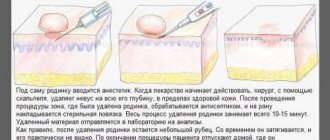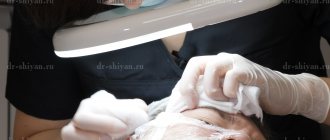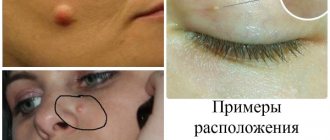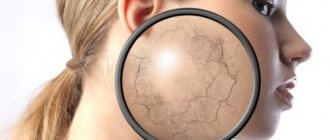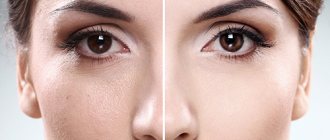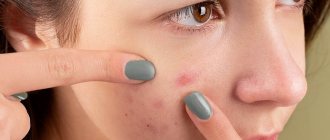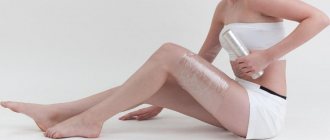Small marks in the form of moles and birthmarks sometimes add charm, and sometimes cause a lot of inconvenience to their owners. Unfortunately, not every mole can be removed. And the main difficulty is not the postoperative scar, but safety for human health. The potential danger of a mole is that it can become malignant - evolve into a malignant tumor. And to eliminate the cosmetic effect, the patient is required to undergo several tests to exclude malignant degeneration of the tumor.
Before applying for mole removal, we recommend that you observe it. There are “calm” and “suspicious” moles. Only a specialist can make a final verdict regarding this or that formation, who will direct you to a series of tests and make the correct conclusion. But you can first determine how “calm” an unattractive mole is on your face or body. Our leading specialist Kirill Viktorovich Listratenkov has extensive practical experience in laser surgery, so we will be happy to help you remove your mole painlessly, atraumatically, and of course, safely.
What do we know about moles?
What we have always heard about moles: “Does it bother you? Live in peace, don’t touch your mole!” This advice, which was very common in the past, convinced us that moles that were originally given by nature or that appear over the years should remain inviolable. If you touch it, you won’t be able to avoid trouble. This is partly true - indeed, removing moles can lead to the most dire consequences. But in fairness, it should also be noted that not every mole needs to be removed. The most harmless - flat moles
(pink to dark brown).
Usually they behave “quietly”, do not get injured and do not create inconvenience. The only thing you need to remember is to protect such moles (on open areas of the body) from sunlight. Convex moles
, especially if they are often touched by clothing, need to be treated more carefully. If they are on the back and in other places inaccessible to your view, you should entrust someone close to you with monitoring them. And, of course, if any changes occur—the mole becomes larger, turns from flat to convex, or changes its shape—you should immediately contact a specialist.
Celandine tincture
Medicinal tincture of celandine.
Recipe: To prepare the medicinal liquid, you will need fresh celandine leaves, strong vodka or medical alcohol. The leaves need to be washed, dried a little, put them in a glass jar and put it in a dark place for two weeks. After this time, the liquid must be taken out, filtered and poured into a hermetically sealed container. The tincture should be diluted with ordinary water 1:1, moisten a cotton swab in it and apply it to the candyloma.
No independence.
Some people believe that you can remove moles yourself by tying them, for example, with silk thread. This is a deep misconception. Attempts to bandage warts and papillomas with a thin silk thread often only provoke the growth of these formations. Today, there are celandine-based preparations on sale that are intended to eliminate warts. But it is better not to remove moles, papillomas, or warts yourself by any means. Celandine juice is similar in composition to iodine, so prolonged exposure to the drug causes skin burns. Cauterization with iodine is even more dangerous - it is more aggressive than celandine. Trying hard to get rid of papillomas with iodine, you can get scars on the skin. Only a dermatologist can properly remove a mole.
Celandine ointment
Various medicines can be made from celandine juice: ointment, tincture, extract.
Recipe: Cut off the celandine at the very root, thoroughly wash it from dirt, dry it and squeeze out the juice from it. Add the resulting liquid to Vaseline and mix until smooth. It is best to store the mixture in a dark and cool place. We lubricate the mole with cream, wait until it is absorbed a little and go about our business. We repeat this manipulation 2-3 times a day.
Removal methods.
Removal of moles and warts
- Cost: 2,000 rub.
More details
Mole removal can be carried out using a laser, radio wave coagulation or electrical coagulation. These manipulations are performed on an outpatient basis under local anesthesia. The choice of treatment method is determined by the doctor in each specific case. In my opinion, the most effective and painless method is radio wave coagulation. We use this technique in most cases, although in some cases we use excision with conventional surgical instruments followed by suturing. When using radio wave coagulation, tissue damage during material collection will be minimal, blood loss is reduced, and the rehabilitation period is shortened, while, for example, with the laser method, the healing process is extended over a fairly long period. Repeated formations do not appear after removal, but if precautions are not followed by the patient himself, infection may occur.
Price
In fact, there is no need to save on such pathology by using the services of beauty salons or traditional medicine recipes.
The best option would be to undergo treatment at a special cancer center or a simple medical clinic.
Basically, in such centers you will not only have your mole removed, but will also undergo a histological examination of the removed tissue.
The average price for removing a nevus in a good Moscow clinic ranges from 320 rubles per 1 millimeter of skin.
However, the cost of the procedures varies depending on the technique used.
- Surgical removal – about 1100 rubles;
- Photodynamic therapy – about 5200 rubles;
- Laser removal – about 2300 rubles;
- Removal with the Surgitron device – about 2700 rubles;
- Laser removal from 600 to 2500 rubles;
- Laser therapy – from 600 rubles and above.
Unattended moles.
Some types of moles can degenerate into one of the most malignant tumors - melanoma (skin cancer). The initial site of formation of most melanomas is congenital pigment spots and warty moles. How does this dangerous development begin?
For example, after damage, a person only notices how the color of the mole begins to change, it enlarges, cracks, turns into an ulcer, and sometimes into a tumor. Therefore, without panicking, pay attention to the above symptoms, especially the progressive enlargement of the mole and change in its color. If all these symptoms occur, immediately rush to the dermatologist. The unfavorable prognosis of melanoma dictates the need for regular monitoring by a doctor. In addition to irritant factors (ultraviolet radiation, trauma), the development of melanoma can also be caused by genetic and endocrine factors. However, in the first place is, of course, excessive exposure to the sun. Ultraviolet radiation in large doses causes irreversible changes in skin cells, greatly increasing the risk of their degeneration. Light-skinned and fair-haired, red-haired people with blue and gray eyes are most susceptible to the mutagenic effects of sunlight. Those at risk also include those who have a lot of freckles, age spots and moles.
Classification and characteristics
In total, approximately 60 types of formation have been identified, which are determined by dermatologists or oncologists. They are divided by appearance, size, shape, content and other parameters. Moles can be small, excessively large, up to 15 cm in diameter. If they are localized on the face, this leads to a severe cosmetic defect.
Classification by time of occurrence:
- congenital
- they are formed very rarely, have a small size, which makes them very difficult to see instantly; - acquired
- spread to the upper, deep, middle layers of the skin, between the dermis and epidermis.
The main types of nevi and their exact characteristics are presented in the table.
| Variety | Description |
| Nevus | Has a brown or black tint. Can be located in any area of the body. More common on the face |
| Blue nevus | Smooth, superficial, with a dense consistency. Their diameter is no more than 10 mm. The shade is dark brown or black. Localized singly on the body |
| Angioma | A network of capillaries and blood vessels grows in the epidermis. This leads to the formation of a benign tumor that remains under the skin |
| Lentigo | Presented on the body in the form of a brown or black pigment spot. Singularly located. Rarely found |
It is important to classify the mole before starting treatment so that mechanical impact does not lead to complications.
Dangerous sun.
For each person, the critical duration of exposure to sunlight is highly individual. It’s not easy to determine this line, so it’s better to just remember that prolonged exposure to the sun is harmful to the body. The skin is forced to protect itself from ultraviolet radiation. Excessive tanning means inevitable burns. If you love beach holidays so much that you simply cannot deny yourself this pleasure, at least listen to the following tips. By following these simple recommendations, you will not only improve your health, but also reduce the risk of a dangerous disease.
- Staying in the sun is safe from morning until 10 o'clock, in the evening after 17 o'clock.
- For people with a large number of moles, it is better to reduce their exposure to the sun.
- Try to avoid redness and sunburn on your skin. If this happens, spend 2-3 days in the shade.
- After swimming in the sea, be sure to rinse your skin with fresh water.
- Even young and healthy people can spend no more than one and a half to two hours a day in the sun.
- Taking certain medications increases the skin's sensitivity to light. Please consult your GP before going on holiday.
- Use sunscreen cosmetics: at the beginning of the holiday, the indicator should be maximum, about 40 units.
- Do not use decorative cosmetics, deodorants and perfumes on the beach - they can cause the appearance of age spots on the skin.
Prevention
Before you think about how to get rid of all moles on your face, you need to prevent the appearance of new ones. To do this, swelling should not be allowed.
Prevention involves:
- maintain sleep and rest patterns;
- sleep in the correct position - use a high and hard pillow so that the head is raised 10-15 cm;
- switch to a healthy diet;
- limit salt intake;
- eat your last meal 3 hours before bedtime;
- drink 1.5-2 liters of water during the day, but drink it last 3 hours before bedtime;
- actively engage in sports (running, swimming);
- walk for at least an hour every day;
- take a contrast shower in the morning.
Possible consequences
After professional removal of nevi, the consequences are minimized, but there is still a small risk of their manifestation:
- Infection in the wound , when caring for it after the session was inappropriate, the recommendations of the attending physician were ignored;
- Degeneration into melanoma cannot be predicted, because it is associated with a hereditary factor or the characteristics of the patient’s body;
- A pigment-free area of the skin may remain after the nevus is exposed to a laser, but it will be practically invisible against the background of the skin;
- Formation of scars and cicatrices , which may be due to the regenerating characteristics of the patient’s skin.
When using folk remedies, negative consequences are very often encountered, because in response to a prolonged irritating factor, the nevus is able to begin the process of degeneration at a very rapid pace, thereby causing cancer of the patient’s skin.
The best option for you would be not to prescribe treatment for yourself or on the advice of other people, but simply seek advice from a doctor.
A highly qualified specialist is able to solve your problem and guarantee the complete safety of this or that method for your health.

